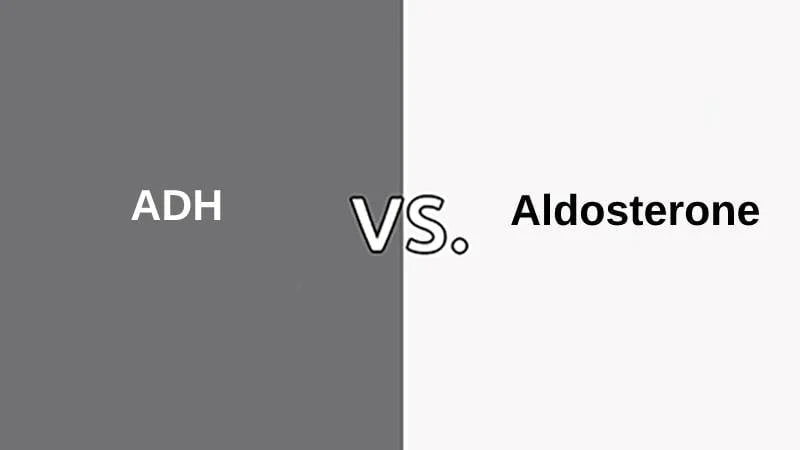The Human body is a combination of various systems. The functioning of the systems must be monitored, and their rhythm must be altered accordingly to match the environment. Hormones, periodically released by the endocrine glands, are responsible for the body’s adoption to various situations. Among the hormones secreted, ADH and Aldosterone are equally essential.
ADH vs Aldosterone
The main difference between ADH and Aldosterone is that ADH helps maintain our body’s water content. In contrast, Aldosterone helps maintain both water and salt in the blood. ADH and Aldosterone act over the kidneys to control the absorption of water by the blood.

ADH, an Antidiuretic hormone, acts upon the kidneys to control the water absorption and excretion cycles. ADH is a peptide hormone whose major constituent is protein. Their zone of secretion is different from that of the zone of action. ADH is responsible for making us feel thirst upon the critical water level in our body.
Aldosterone is a steroid-based hormone. Unlike ADH, Aldosterone is secreted right above its zone of action. The zone of action is the kidneys for ADH. It regulates the water content as well as the content of salt in the blood. This hormone regulates the reabsorption of sodium salt in the bloodstream.
Comparison Table Between ADH and Aldosterone
| Parameters of Comparison | ADH | Aldosterone |
| Alternate name | Arginine Vasopressin | Aldocorten, Aldocortin, Electrocortin, etc. |
| Zone of Secretion | It is secreted in the Hypothalamus. | This hormone is secreted in the Adrenal gland. |
| Zone of Action | It acts on Kidneys to regulate the reabsorption of fluid. | It acts on Kidneys to regulate the reabsorption of fluid and electrolytes. |
| Significance | This maintains proper water content in the body. Maintains blood pressure under optimal level. | This hormone maintains water content and regulates the reabsorption of Salt in the bloodstream. Decreases the salt concentration when the blood pressure hikes. |
| Type | It is a Peptide hormone non-permeable cell membrane. | It is a Steroid based hormone with a permeable cell membrane. |
What is ADH?
Antidiuretic Hormone(ADH) is one of the vital hormones essential for the optimal functioning of the human body. Hypothalamus secretes ADH. The secreted hormone is stored in the posterior pituitary gland and released whenever required.
ADH is released into the bloodstream when the blood osmolality (a medical term used to represent the number of dissolved particles in the blood) increases. When the ADH saturation in the blood is low, the kidneys are forced to excrete too much water either through urine or the skin, as sweat compels one to drink water.
If the water content in the body is too low, the hypothalamus secretes the ADH hormone, which creates an urge to drink water by making the individual feel thirsty.
Thus ADH is an absolute lifesaver because it helps neutralise blood pressure levels by increasing blood volume.
The blood volume can be increased by lowering the water concentration in the blood, and this hormone helps the kidney reabsorb the same. The effect of ADH could last only for 16 to 24 minutes.
Besides managing the fluid concentration, it is sometimes released directly into the brain. The released ADH into the brain helps maintain proper social behavior, sexual motivation, and stress management.
What is Aldosterone?
Aldosterone is a steroid-based hormone secreted and released in response to the body’s improper salt and water content. It gets secreted in the adrenal gland.
It is secreted as a resin, angiotensin, and aldosterone complex. The production of Aldosterone is not a single-step process. The kidneys produce a hormone called renin upon stimulus. The renin is sent to the liver, then permutes as Angiotensin I.
Angiotensin I gets converted into Angiotensin II in the lungs. The final product, Angiotensin II, is sent to the adrenal gland over the kidneys to produce the Aldosterone hormone.
Increased potassium and low sodium concentrations in the bloodstream induce the production of Aldosterone. Aldosterone helps maintain proper fluid balance and increases and decreases sodium and potassium concentration in the blood. This hormone is responsible for lowering blood pressure under a hypertensive state.
Aldosterone is a complex of resin, angiotensin, and aldosterone with a plasma half-life of 20 minutes. When Aldosterone concentration is high, it increases blood pressure, makes one feel weak, and even causes paralysis in rare cases.
It is an everyday hormone that is secreted only on a milligram basis. To be short, Aldosterone helps to maintain healthy water and sodium levels. However, it excrets excess potassium to lower blood pressure.
Main Differences Between ADH and Aldosterone
- ADH is a peptide-based hormone, whereas Aldosterone is a steroid-based one.
- ADH is secreted in the hypothalamus and acts on the kidney to regulate water reabsorption. Aldosterone is secreted by the adrenal gland on the kidneys to regulate water and salt content.
- ADH responds faster than Aldosterone, while the former is lipophobic and the latter is lipophilic.
- ADH utilizes a water channel, but Aldosterone uses an osmotic pressure gradient.
- ADH affects the normal concentration of the blood, but Aldosterone doesn’t affect the small concentration.
- The cell membrane of ADH isn’t water-permeable, whereas Aldosterone has a water-permeable cell membrane.
Conclusion
Human anatomy is a complex structure that involves a lot of research to establish the significance of every organ completely. The years that have passed opened up everything considered mysterious due to technological advancement. This technology gets improved every day as new research outcomes and discoveries arrive.
ADH and Aldosterone are hormones secreted in a fluid form that helps us live according to the changing environment. Though secreted in various body parts, they act on kidneys in their own way. They let us live by constantly monitoring and maintaining the proper fluid and electrolyte levels